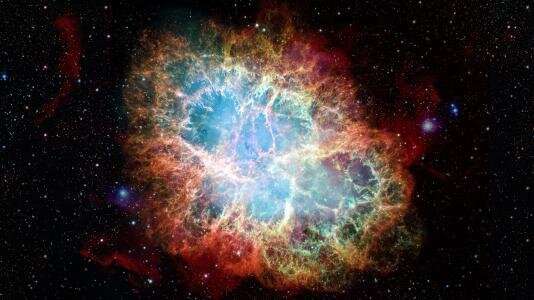This article has been reviewed according to Science X's editorial process and policies. Editors have highlighted the following attributes while ensuring the content's credibility:
fact-checked
trusted source
proofread
Laser shots could spark additional discoveries in astrophysics

In December, the National Ignition Facility (NIF) at the U.S. Department of Energy's (DOE) Lawrence Livermore National Laboratory made headlines worldwide. Scientists at the NIF performed the first nuclear fusion experiment in which the energy produced from fusion exceeded the amount of energy directly applied to the fuel to ignite it. This first-of-its-kind result will provide invaluable insight into the potential for clean energy from fusion.
But the NIF's scientific impact doesn't end there. Using the Argonne Tandem Linac Accelerator System (ATLAS), a DOE Office of Science user facility located at DOE's Argonne National Laboratory, a team of scientists is studying the extreme, star-like environment created during laser shots at the NIF to better understand its potential as a testbed for nuclear astrophysics research. The work could also provide insight into the nature of stars and the origin of the elements.
Simulating the heavens on earth
The heavy elements—including gold, platinum and uranium—form in stellar explosions such as supernovae and neutron-star mergers. During NIF laser shots, 192 laser beams focus to ignite a tiny capsule of fusion fuel, creating pressures and temperatures found inside extreme stellar events. This makes the facility a powerful tool for exploring the nuclear physics involved in the formation of heavy elements and improving models of stellar explosions and the early universe.
"The environment created during the NIF experiments is tiny and very short-lived, so it's not exactly a star," joked ATLAS user Michael Paul, a scientist at the Hebrew University of Jerusalem and lead scientist in the collaboration. "But the thermodynamics happening inside the environment are very close to that of stars—particularly exploding stars. If we can reproduce these astrophysical conditions on earth in a laboratory, we can study stellar processes in detail in a well-characterized environment close to home."
Specifically, the team is searching for evidence of the rapid neutron-capture process, or r-process, which is responsible for the production of about half of the heavy elements in nature.
Neutrons are particles that—along with protons—make up the nucleus at the center of an atom. Neutron capture is when an atomic nucleus absorbs a neutron. The starting nucleus and the product nucleus are isotopes, or forms of the same element. Some isotopes are more stable, and some are more radioactive, meaning they decay into another isotope more quickly.
In extreme stellar conditions, the density of neutrons is incredibly high. These neutron rich environments allow nuclei to grow by capturing many neutrons very rapidly, producing atoms of new and heavier elements before they have a chance to decay.
Analyzing argon at Argonne
In the NIF-ATLAS experiments, scientists insert a small amount of argon gas inside the fusion fuel capsule before the fuel is ignited by the NIF lasers. Like atomic spies on a mission for the scientists, the argon atoms are sent into the capsule to retrieve and store information about its interior during the shot.
After the laser shot, the argon is transported to ATLAS at Argonne, where the scientists search for evidence that an argon-40 nucleus (an argon isotope containing 40 subatomic particles in its nucleus—18 protons and 22 neutrons) captured two neutrons at once during the laser shot, becoming argon-42. "If we see this, it will be the first time that an r-process-like event has been detected in a reproducible laboratory setting," said Paul.
Argon-42 is radioactive but decays slowly, so it persists long enough for the team to transport it to ATLAS and analyze it before it decays. The gas is analyzed using a unique method developed at Argonne called Noble Gas Accelerator Mass Spectrometry (NOGAMS). NOGAMS is an ultra-sensitive method for counting the number of individual atoms of a certain isotope in a sample.
The scientists chose to use argon because it is a noble gas, which means it doesn't react chemically with other substances or interfere with the fusion fuel in the capsule. This inertness also makes it more difficult to accelerate and detect using traditional accelerator mass spectroscopy methods. The unique approach of the NOGAMS technique makes ATLAS the only facility that can count noble gas atoms.
"The capabilities at ATLAS are what make this investigation possible," said Argonne physicist Melina Avila Coronado. "It's exciting to think what insight into stellar processes may come from this."
Avila Coronado helps users like Paul and his team operate and take measurements with the magnetic spectrometer at ATLAS. Preliminary experiments took place in 2022 and demonstrated nuclear reactions of argon-40 in the fusion environment. The team is set to continue their search for evidence of the r-process and other astrophysical processes of interest in 2023.
Provided by Argonne National Laboratory





















